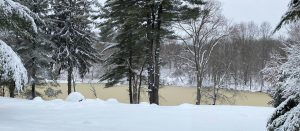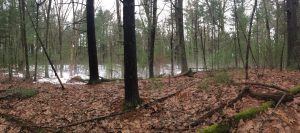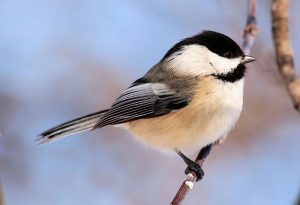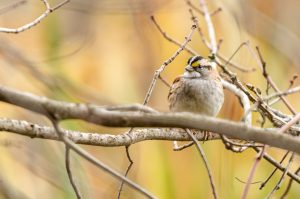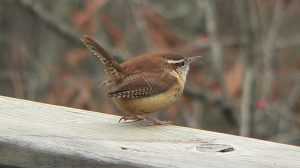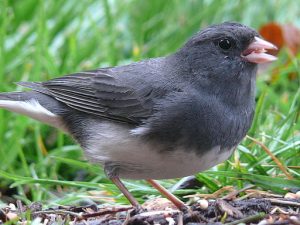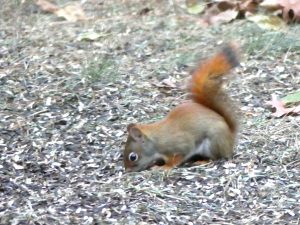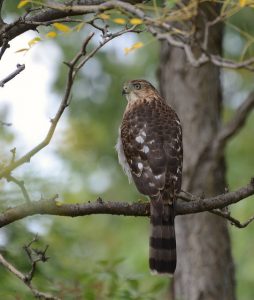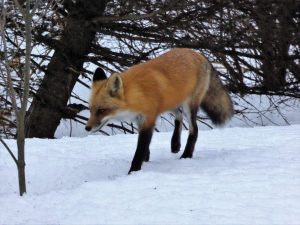Written by Gwyn Loud for the Lincoln Land Conservation Trust. She welcomes your sightings and questions at 781-259-8690 of gwynloud555 (at) gmail.com
Once again we have been on a weather roller coaster over the last month. Winter will not begin officially until Dec. 21, the solstice, but it got a head start Dec. 1-3 when over a foot of snow fell, closing schools, and sending us to pull out snow shovels and roof rakes earlier than usual. We stayed in the deep freeze for days, which prevented much melting of snow. A neighbor took the attached photo of Valley Pond soon after the snow fell; it was odd to see the pond look like “butterscotch”. It seems likely that the thin ice under the snow allowed the pond water, brown with tannin, to be absorbed into the slushy snow. By December 10 we were back to tee shirts and shorts, with the temperature rising to 60ºF! The sudden warmth, melting the snow, led to a foggy night. After the solstice, the shortest day of the year, hours of daylight will gradually lengthen and we are likely to start hearing the spring “fee-bee” call of the black-capped chickadee, prompted by day length rather than weather.
It is remarkable how warm-blooded animals, such as songbirds, survive bitter cold winter nights. Luckily, they have evolved survival strategies. One of these is to puff up their feathers, which helps trap their body heat (warmer than ours, about 105ºF), close to the body. There is a reason humans buy jackets filled with down feathers; we are copying the birds! Birds eat frantically during daylight to maintain their metabolism and high body temperature, but at night they lower their body temperature so there is less heat loss when they are resting. They survive on the fat built up during the day. As dark falls, birds find protected places such as evergreens or tree cavities and they tuck their beaks under their feathers, sometimes shivering or huddling together to keep warm. Woodpeckers will peck roosting holes in trees and I often see a downy woodpecker dart into an empty bird house at dusk. Inadvertently, I have startled birds seeking overnight shelter in our barn.
The recent snow brought eager birds to feeders, mostly the usual crowd: blue jays, tufted titmice, black-capped chickadees, white-breasted nuthatches, downy, hairy, and red-bellied woodpeckers, house finches, and goldfinches. Feeding on the ground we see mourning doves, dark-eyed juncos, and white-throated and song sparrows. Eastern towhees turned up in a couple of places, and there have been occasional visits from brown-headed cowbirds, grackles, and red-winged blackbirds. Carolina wrens, singing year-round, pay perky visits and love suet. Cooper’s hawks often prey on birds near feeders; it is a fast-food restaurant for them and a pile of feathers on the snow is a tell-tale sign of a meal. Of course birds primarily eat wild food and a Lexington Road resident has been enjoying watching them feeding on seed heads of native plants he has planted. Flocks of cedar waxwings and robins feed on berries all winter. Insects continue to be an important avian food source, often hidden under bark as eggs or pupae and there are even caterpillars which overwinter frozen on tree branches.
Wild turkeys have been parading in flocks, the males fanning their tails, their heads a brilliant blue. Some lingering chipping sparrows as well as a yellow-bellied sapsucker and a ruby-crowned kinglet turned up at Drumlin Farm. Great horned owls have been hooting, sometimes in male-female duets, and they will be our earliest nesters in the new year. The annual Winter Finch Forecast from Ontario predicts that, due to a splendid crop of cones and seeds in Canada, we will not see many irruptive species such as red-breasted nuthatches, pine siskins, and redpolls this winter as they will have plenty to eat up north.
The annual Christmas Bird Count is organized all over the country by the National Audubon Society within a two-week window. The data collected gives valuable information about population numbers of species and their range and the impacts of climate change and other factors. Lincoln is part of the Concord Bird Count and our date is December 29 this year. Townspeople who would like information about participating either as part of a field team or counting birds at feeders should check the website: https://concordcbc.org or call Norman Levey at 781-259-1162 or contact me.
Most mammals continue to be active in winter and the recent light snow offered a chance to observe many of their tracks. Several observers still see chipmunks, which do not hibernate but spend a good part of the winter dozing in underground tunnels, emerging to feed in warm spells. A Winter Street resident had sightings of a red fox, beautiful against the snow, and of course gray and red squirrels are busy near bird feeders. While skiing in Browning Field I stopped to open a bluebird house and clean it out. When I opened the box, however, a surprised mouse popped up, comfy on a bed of grass and feathers. I left it to stay snug for the winter.
As this is my final wildlife column of 2019, I would like to take the opportunity to thank my “official team” of wildlife observers: Matt Burne, Stacy Carter, Vin Durso, Marcia Gagney. Tom Gumbart, Nancy Hammond, Colleen Katsuki, Sue Klem, Jane Layton, Norman Levey, Kathleen Lomatowski, Ron McAdow, Harold McAleer, Ellen Meadors, Alaric Naiman, Corey Nimmer, Tia Pinney, Kathy Seymour, Nancy Soulette, Pam Sowizral, Rob Todd, and Robin Wilkerson. I am also grateful for the calls and e-mails from other observant townspeople who appreciate the many forms of wildlife around us. Thanks also go to Bryn Gingrich who puts the column on the LLCT website, along with photos.


